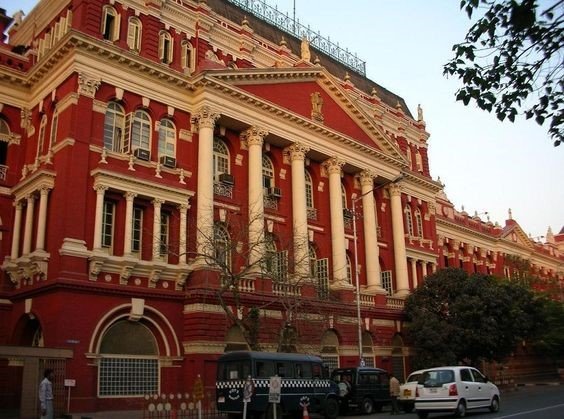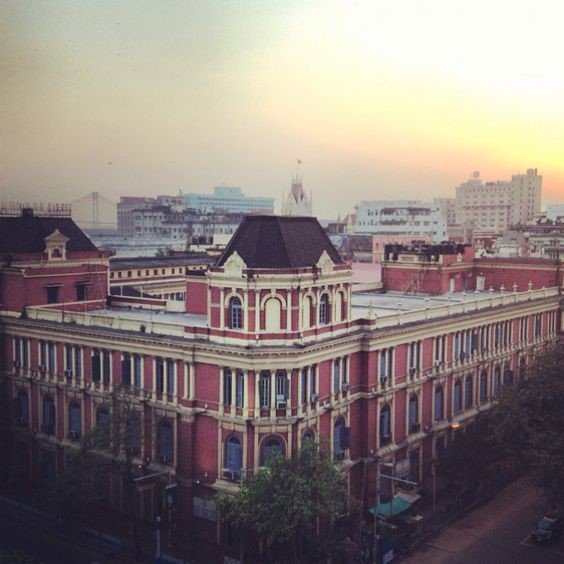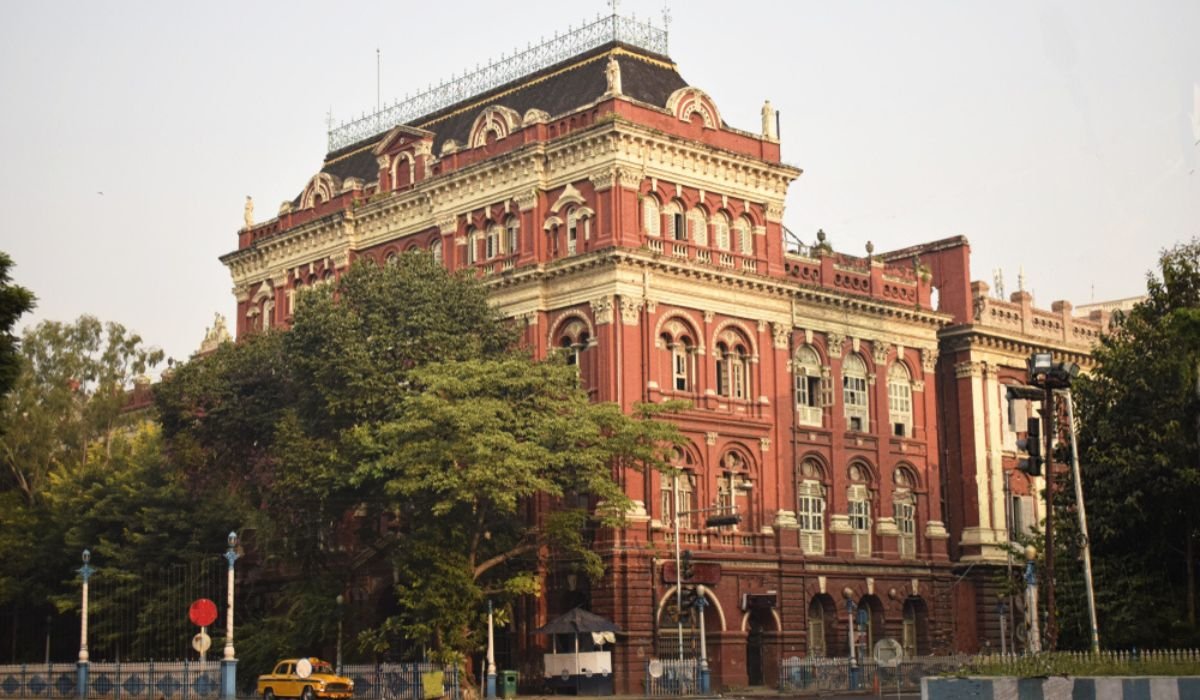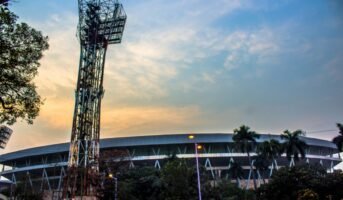Regarded as Kolkata’s first 3-story structure, the Writers’ Building in BBD Bagh (Dalhousie Square) is a renowned landmark. It is now the West Bengal Government Secretariat and is estimated to be valued at around Rs 653 crores.
The breathtaking architecture and interior design of the Writers’ Building in Kolkata bring in tens of thousands of visitors from all over the globe every year. It is an impressive 150 metres in length and many sculptures honouring Greek deities and the Roman goddess Minerva can be found within the structure.
The enormous complex comprises a total of 13 blocks, the last six of which were not built until after India attained its independence. Many sculptures depicting Greek deities and a sculptural representation of the Roman goddess Minerva may be seen throughout the structure.
How to reach Writers’ Building Kolkata?

Source: Pinterest
Address: Binoy Badal Dinesh Bag N Rd, Lal Dighi, B.B.D. Bagh, Kolkata, West Bengal 700001
By air: The closest airport is Kolkata’s Netaji Subhas Chandra Bose International Airport, which provides service to all important cities in India. Once you have arrived, prepaid taxis or rental cabs can take you to the Writer’s Building.
By train: Trains to all of India’s main cities depart from and arrive at Howrah Junction Station, the closest station. Visitors can take a bus, prepaid taxi or book a cab via one of Kolkata’s many reliable vehicle rental agencies. It is also possible to take a bus to BBD Bagh.
Local transport:: Public transportation is plentiful and includes taxis, auto rickshaws, and the city’s historic trams, making it the only city in India with a functioning tram system. Writer’s Building’s tram stop is at B.B.D Bagh.
Writer’s Building, Kolkata: Timings and entry fees
| Day | Timings |
| Monday – Saturday | 10:00 AM – 6:00 PM |
| Sunday | Closed |
Entry Fee: There is no entry fee to visit Writer’s Building.
Writer’s Building, Kolkata: History and architecture

Source: Pinterest
The Writer’s Building, commissioned by Richard Barwell in 1777, was designed by the self-styled builder Thomas Lyon. The East India Company commissioned the structure, which had the name “Writers,” to accommodate its entry-level service personnel. Warren Hastings, the state’s former governor, was the one who originally proposed centralising administration functions.
At the time, this structure was meant to serve as the headquarters for the East India Company, which at the time was active in the Bengal region of the Mughal Empire. After a few years, Fort William College was established there to provide education in Persian and Hindi, two other languages that saw heavy usage in government communications.
Additionally, the original structure underwent structural renovations to accommodate the requirements of the institution, such as the addition of a dorm and an exam room.
Writer’s Building, Kolkata: Current valuation

Source: Pinterest
Many are curious about how much money the Writer’s Building is worth. The total area of the property is around 10 acres, or 4,35,600 square feet of commercial land in the upscale Benoy-Badal-Dinesh Bagh office neighbourhood, where commercial space typically sells for between Rs. 14,000 and Rs.15,000 per sq ft. Bearing the current market rates, the Writer’s Building is valued at over a whopping Rs 653 crores. Taking into account the building’s historical and archival importance, the value is expected to rise dramatically.
Writer’s Building, Kolkata: Interesting facts
- As Kolkata’s first 3-story building, the Writers’ Building has a special place in the city’s history.
- The Writers’ Building serves as the headquarters for the West Bengal State Government.
- The Writers’ Building is also home to the West Bengal Chief Minister’s office.
- Historically, the Writers’ Building was the location of Fort William College, which provided instruction in Oriental languages to aspiring authors.
- One of the oldest and largest libraries in West Bengal is the West Bengal Secretariat Library, which can be found in the Writers’ Buildings.
- West Bengal’s current chief minister, Mamata Banerjee, came to prominence in 1993 when police opened fire on a protest march she led to the famous Writer’s Building.
- On December 8, 1930, three infamous freedom fighters named Benoy Basu, Dinesh Gupta, and Badal Gupta stormed the Writers’ Building while disguised as Europeans. They murdered Colonel N.S. Simpson, the inspector general of the police force, after he ordered the convicts to be tortured severely. When Simpson refused to give up, they murdered him and then Badal, Benoy, and Dinesh committed suicide by shooting themselves.
Writer’s Building, Kolkata: Library
Literature from the British period all the way up to the current day is represented in the library’s extensive collection. This library was founded in 1921 and has been run by the Education Department of the Bengal Government of undivided India ever since. In 1945, it became part of the Secretariat of the Chief Minister. The library was moved to the Home Department Writers’ Buildings when the United States declared independence on August 15, 1947. Dr Bidhan Chandra Ray, West Bengal’s former Hon’ble Chief Minister, spearheaded the library’s construction and refurbishment.
On June 9, 1961, Dr B.C. Roy officially launched the library on the first floor of the F-Block of the Writers’ Buildings. Library resources at the West Bengal Secretariat comprise mostly English-language literature from the 18th and 19th centuries. About 60,000 of the library’s 2 million books are considered to be either uncommon, old, worn, or fragile.
Writer’s Building, Kolkata: Renovation challenges

Source: Pinterest
Late in 2013, a $2 billion (around $US28 million) renovation was completed on the building. The state Secretariat and Chief Minister’s office were subsequently moved to Nabanna, an abandoned skyscraper in Howrah owned by the Hooghly River Bridge Commissioners Office, to make this happen.
After environmentalists and the state’s public works department found the architect firm’s proposed design to be unsatisfactory in February 2014, construction on the project was halted. A group of architects from Jadavpur University and the Indian Institute of Engineering Science and Technology, Shibpur, were also invited to conduct testing on the structure before any renovations could commence.
Renovations included participation from the Indian National Trust for Art and Cultural Heritage (INTACH). The group consulted international experts in historic preservation from places like Australia and Germany before putting out their final proposal in the fall of 2015. Construction on the ground, however, had not begun by mid-2016 owing to government uncertainty and bureaucratic red tape.
A significant amount of time and money has been invested, and the renovation deadline has been repeatedly missed. Despite having been underway for over nine years, not even half of the renovations have been finished prompting the inevitable inquiry as to whether or not this 250-year-old landmark edifice built by the British can ever regain its previous bustling atmosphere.
Writer’s Building, Kolkata: Is it haunted?

Source: Pinterest
The various legends surrounding Writer’s building have led to its status as a haunted location in Kolkata. Several of the building’s chambers have been unoccupied for decades, and no one works there beyond the dark. Unusual sounds, such as squeals, screams, and whispers, reported by many could be heard in these rooms late at night. Some of the popular incidents are:
- On December 8, 1930, Benoy, Badal, and Dinesh went to the building where the infamous police inspector general colonel Simpson worked and killed him because of his violent treatment of Indian convicts. Colonel Simpson was shot dead by three teenage rebels, and his ghost is said to haunt the area ever since. Guests often express dissatisfaction with the constant background noise of shuffling feet, childish laughter, and shrill crying.
- In the 1970s, a prominent Calcutta newspaper reported on the story of night guard Munshiram, who, while patrolling the first-floor hallway of the first block, saw the ghostly apparition of a White man in a suit, obviously severely hurt and bent over. While this was happening, Munshiram heard the clacking of heavy boots ascending the stairs. His panic caused him to shout for help to block one sentry before he passed out.
- It is said that Zamiruddin, the Writers’ equivalent of a head of housekeeping, haunts the fifth floor of the building and that he was seen by various chief ministers, including Dr B.C. Roy.
Know about: Room rent in Kolkata
FAQs
Who constructed the writers' building?
The very first three-story structure in ancient Calcutta was the Writer's building, which was constructed in the neoclassical style and had beautiful Corinthian columns. The Writer's Building was erected in 1777 by Thomas Lyon, a self-proclaimed builder, on behalf of Richard Barwell.
What is the current designation of the Writers building?
The region around Writers has been known by several names throughout history. Tank Square was renamed Dalhousie Square after the governor-general of India and BBD Bagh after the three rebels who murdered the British officer in 1930.
What is the Writers building's architectural style?
Under British occupation, the structure was remodelled in the French Renaissance style to make it look more elaborate and nearly palatial in terms of architecture. The Writers' Building has been a quiet witness to many historically significant political occurrences.
Who stormed the Writers Building?
Badal, Dinesh Gupta, and Benoy, disguised as Europeans, invaded the Writers' Building on 8 December 1930 and murdered Simpson. In response, officers in the building opened fire on the suspects. A short gun battle erupted between the three young revolutionaries and the cops.
Harini is a content management professional with over 12 years of experience. She has contributed articles for various domains, including real estate, finance, health and travel insurance and e-governance. She has in-depth experience in writing well-researched articles on property trends, infrastructure, taxation, real estate projects and related topics. A Bachelor of Science with Honours in Physics, Harini prefers reading motivational books and keeping abreast of the latest developments in the real estate sector.










